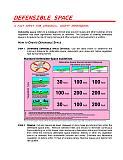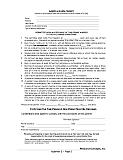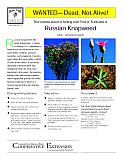Appendix D - Homeowner Guidelines
Homeowner Guidelines
Defensible Space Guidelines
Download the Defensible Space Guidelines fact sheet for Churchill County

(PDF, 153kb, 2 pages)
Homeowner’s Annual Checklist
Download the Homeowner’s Annual Checklist fact sheet for Churchill County

(PDF, 36kb, 1 page)
Sample Burn Permit
Download the Sample Burn Permit fact sheet for Churchill County

(PDF, 33kb, 1 page)
Noxious Species: Russian Knapweed
Russian knapweed (Acroptilon repens) is a state-listed noxious weed. Together with other state-listed members of the same genera: Diffuse, Spotted and Squarrose knapweed; these weeds fall under the definition of noxious: “any species of plant which is, or is likely to be, detrimental or destructive and difficult to control or eradicate” by the Nevada Revised Statutes (NRS 555.005, Nevada Administrative Code 555.010). The provisions of the NRS and Nevada Administrative Code designate noxious weed control as the responsibility of every landowner or occupant. The law also provides for the establishment of weed districts, which have authority to control noxious weeds.
Within Churchill County, the Mosquito and Weed Abatement District handles weed control for the County. The district has authority to control noxious weeds along roads and right-of-ways. They commonly treat puncturevine (Tribulus terrestris), annual kochia, saltcedar (Tamarix rammosissima), African rue (Peganum harmala), Russian knapweed, and tall whitetop (Lepidium latifolium). The Abatement District is currently mapping noxious weeds in the County and participates in weed control programs with NDOT, Truckee-Carson Irrigation District (TCID), the County Road Department, the U.S. Fish and Wildlife Service, and the Lahontan Conservation District. TCID controls weeds along the Carson River, ditches and drain rights-of-ways.
Russian knapweed was noted as growing in the Fallon Outskirts and the Stillwater area. Though knapweed was not found in all communities, it can be prevalent in heavy soils, especially along ditches and formerly irrigated fields. It is an invasive perennial plant that can spread rapidly if control measures are not enforced. Though not typically a high fuel hazard, Russian knapweed’s propensity to spread and form high-density patches highlights the responsibility of all landowners to work together to decrease the current rate of spread and density of the species. For more information about how private landowners can get involved in the control effort call Nancy Upham, Mosquito and Weed Abatement District Manager at (775) 423-2828, or the Natural Resources Conservation Service at (775) 423-5124.
Download the Russian Knapweed info sheet for Churchill County

(PDF, 256kb, 2 pages)
Seed Mix and Application Specifications
Revegetation Specifications for Fuel Reduction Areas and Greenstrips - Churchill County
| Common Name | Scientific Name | Seeding Rate PLS pounds/acre | |
|---|---|---|---|
| Drill Application | Broadcast Application | ||
| “P-27” Siberian wheatgrass * | Agropyron fragile spp. sibericum | 2.00 | 4.00 |
| “Nezpar” Indian ricegrass | Achnatherum hymenoides | 2.00 | 2.00 |
| “Ephraim” Crested wheatgrass * | Agropyron cristatum | 2.00 | 4.00 |
| Bottlebrush squirreltail | Elymus elymoides | 1.50 | 2.00 |
| Scarlet globemallow | Sphaeralcea coccinea | 0.25 | 0.25 |
| “Immigrant” Forage Kochia * | Kochia prostrata | 2.00 | 3.00 |
| TOTAL PLS POUNDS PER ACRE | 9.75 | 15.25 | |
| * Species marked with an asterisk are nonnative plants, but have been included because of their ability to establish and endure a variety of site conditions. In addition, they are recognized for fire retarding qualities. | |||
The seed mixture provided is for treating all disturbed areas, and areas cleared for fuel reduction and greenstrip purposes. All seeds should be thoroughly mixed and seeded together at the same time. Drill seeding is recommended where feasible. Drill rows should be spaced twelve inches apart and seeds should be planted at a depth of 1/2 inch. Broadcast seeding is recommended for rocky, steep, or small treatment areas. The seed can be broadcast using hand held seeders such as a “Whirlybird” type seeder or a seeder mounted on a quad-runner. Continually mix the seed while seeding to equally distribute the small Indian ricegrass and forb seeds throughout the mix. Following the seed application, the seeds should be lightly raked to assure seed placement at an average depth of 1/2 inch. This can be done with hand held rakes or by pulling a drag or piece of chain link fence behind a truck or quad-runner in areas were less stones are on the surface.
These guidelines are provided as overall recommendations. However, site-specific evaluation of the treatment areas by a specialist from a land management agency, the Natural Resources Conservation Service, or the University of Nevada Cooperative Extension will provide even greater assurance for success.
